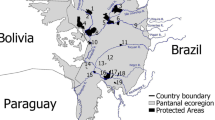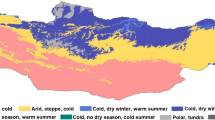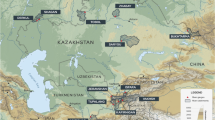Abstract
Since 1960, the steppe regions of North Africa have been subject to an increasing desertification, including the degradation of traditional pastures. The initially dominant species (Artemisia herba-alba, Lygeum spartum and Stipa tenacissima) declined and were progressively replaced by other species (Atractylis serratuloides and Salsola vermiculata) that are more tolerant to the new conditions. It is not clear whether these changes are due to anthropogenic reasons or climatic determinism. We have carried out a statistical analysis of the climate to detect putative rainfall changes during the 20th century in the Algerian steppes based on data from 9 meteorological stations, including 2 Saharan stations (El Oued and Touggourt), 3 pre-Saharan stations (Biskra, Laghouat and Ain Sefra) and 4 steppe stations (Djelfa, Saida, Méchéria and El-Bayadh) located in the arid high plains, which represent the bioclimate diversities of the region. Previous studies suggested that significant rainfall changes for the 20th century only had records in the south of the Oran region. Most of the studies, however, looked at restricted territories over limited periods, and did not integrate the rainiest period 2004–2014. Our work is designed to integrate all the longest time series of meteorological data available for the steppe regions of Algeria. Our results confirm the spatial rainfall distribution (significant rainfall changes only recorded in the southwestern region) evidenced by previous studies, and reveal a decreasing rainfall gradient from northeastern to southwestern Algeria. Moreover, the results reveal a trend of significant decrease of rainfall in the southern Oran region, marked by two drought periods in 1980–1985 and 1999–2003. However, with the exception of the southwestern region, rainfall overall has not declined since the beginning of the 20th century. While less marked in other regions, the drought appear to have affected all territories of the Algerian steppe. Consequently, our study implies that the climate was not a leading influence in the on-going degradation of the vegetation cover of steppe landscapes. Such a vegetation evolution thus appears to be have been determined more by human activities than by climate forcing.
Similar content being viewed by others
References
Aidoud A, Aidoud L F, Slimani H. 1998. Effects of grazing on soil and desertification: a review from the southern Mediterranean rim. In:Papanastasis VP, Peter D. Ecological basis of livestock grazing in Mediterranean ecosystems. Thessaloniki: Office for Official Publications of the European Community, 23–25.
Barakat F, Handoufe A. 1998. Agro-climatic approach to agricultural drought in Morocco. Science and Planetary Changes/Drought, 9(3): 201–208. (In French)
Bechchari A, El Aich A, Mahyou H, et al. 2015. Analysis of pastoral ecosystem in Eastern the Morocco. Journal of Livestock and Veterinary Medicine of the Tropics, 67(4): 151–162. (In French)
Benabadji N, Bouazza M. 2000. Some climate changes occurred in Southwest of Oran (Western Algeria). Renewable Energy Review, 3(2): 117–125. (In French)
Benbrahim K F, Ismaili M, Benbrahim S F, et al. 2004. Problems of environmental degradation through desertification and deforestation: impact of the phenomenon in Morocco. Science and Planetary Changes/Drought, 15(4): 307–320. (In French)
Design Office of Rural Development of Algeria (BNEDER). 2006. Identification and mapping of the agriculture areas in steppe zones: diachronic study of the climate and bioclimate of the Algerian steppe, 47. (In French)
Daget P, Djellouli Y. 1991. Is the Mediterranean climate changing? The drought in Algiers over the last hundred years. Publication of the International Association of Climatology, 4: 187–195. (In French)
Djebaili S. 1978. Phytosociological and phytoecological research on the vegetation of the High Steppes Plains and the Algerian Saharan Atlas. PhD Dissertation. Montpellier: University of Montpellier. (In French)
Djellouli Y. 1981. Climate and bioclimatic study of the southern high plains of Oran: Saida Wilaya. Behavior of species depending on the climate elements. PhD Dissertation. Algiers: Houari Boumediene University of Sciences and Technology. (In French)
Djellouli Y. 1990. Flores and climates in northern Algeria. Climatic determinisms of plant distribution in Algiers. PhD Dissertation. Algiers: University of Sciences and Technology Houari Boumediene. (In French)
Djellouli Y, Daget P. 1993. Consequence of the drought of the last two decades on the Algerian natural ecosystems. Publication of the International Association of Climatology, 6: 104–113. (In French)
Gagnol L, Soubeyran O. 2012. Adapt to adaptation. The Sahelian condition is challenged by the injunction to climate change. Geography and Cultures, 81: 1–12, doi: 10.4000/gc.200. (In French)
Gargouri K, Rhouma A, Sahnoun A, et al. 2008. Assessment of the climate change impact on growing up in Tunisia using GIS tools. Mediterranean Options Series A 80: 349–352. (In French)
Ghenim A, Megnounif A, Djelloul S. 2014. Assessment of changes in the rainfall of the Tafna watershed (northwestern Algeria). In: Laignel B, Nouaceur Z. Water and Climate. El Hammamat: Water and Climate Network, 2: 66–77. (In French)
Gonzalez P, Tucker C J, Sy H. 2012. Tree density and species decline in the African Sahel attributable to climate. Journal of Arid Environments, 78: 55–64.
Gravier J, Weisrock A. 1986. An example of a climatic accident, the drought of 1975–1984 in Morocco. In: Climate and Natural Risk. Paris: French Association of Physical Geography, 139–148. (In French)
Gesellshaft für technische Zusammenarbeit (GTZ). 2005. Climate change: effects on the Tunisian economy and adaptation strategy for the agricultural sector and natural resources. Summary Report, the 1st Step. Tunis: Ministry of Agriculture and Hydraulic Resources. (In French)
Hamed K, Rao A R. 1999. Flood Frequency Analysis. Boca Raton, Florida: CRC Press.
Hanafi A, Jauffret S. 2008. Are long-term vegetation dynamics useful in monitoring and assessing desertification processes in the arid steppe, southern Tunisia? Journal of Arid Environments, 72: 557–572.
Herrmann S M, Anyamba A, Tucker C J. 2005a. Exploring relationship between rainfall and vegetation dynamics in the Sahel using coarse resolution satellite data. In: Global Monitoring for Sustainability and Security. St Petersburg: International Symposium on Remote Sensing of Environment, 79.
Herrmann S M, Anyamba A, Tucker C J. 2005b. Recent trends in vegetation dynamics in the African Sahel and their relationship to climate. Global Environmental Change, 15: 394–404.
Herrmann S M, Hutchinson C F. 2005. The changing contexts of the desertification debate. Journal of Arid Environments, 63: 538–555.
Hirche A. 2010. Assessment of the contribution of the spatial remote sensing in the dynamics of ecosystems in arid zones: South-Oran case. PhD Dissertation. Algiers: Houari Boumediene University of Sciences and Technology. (In French)
Hirche A, Boughani A, Salamani M. 2007. Annual rainfall evolution of in some Algerian dry stations. Science and Planetary Changes/Drought, 18: 314–320. (In French)
Hirche A, Salamani M, Abdellaoui A, et al. 2011. Landscape changes of desertification in arid areas: the case of south-west Algeria. Environmental Monitoring and Assessment, 179: 403–420.
Hourizi R, Hirche A, Djellouli Y, et al. 2017. Spatio-temporal changes in the steppe landscapes of Algeria. Case of Mechéria region. Ecology Journal (Earth and Life), 72 (1): 33–47. (In French)
Kadi M. 1992. Some aspects of drought in North Africa and in the Mediterranean basin. In: Tropical Climates and Their Evolution. Toulouse: National Center for Space Studies. (In French)
Kingumbi A, Bergaoui Z, Bourges J, et al. 2001. The evolution of the rainfall series study of Central Tunisia. In: Servat E, Albergel J. Hydrology of the Mediterranean Regions. Montpellier: Inland Revenue Department, 341–345. (In French)
Laborde J. 1993. Rainfall map of northern Algeria at the scale of 1/500 000, explanatory note. Project UNDP/ALG/88/02. Algiers: National Agency for Hydraulic Resources. (In French)
Le Houérou H. 1989. The variability of annual rainfall in some arid regions of the world; its ecological consequences. In: Bret B (dir.). Men facing drought (Northeast Brazil and African Sahel). Works and memories collection. Paris: IHEAL, 127–137. (In French)
Le Houérou H N. 1996. Climate change, drought and desertification. Journal of Arid Environments, 34(2): 133–185.
Lhote H. 1975. The rock engravings of Oued Djerat: (Tassili-n-Ajjer). Memory of the CRAPE n 2. Algiers: Center of Prehistoric and Ethnographic Researches, 426–830. (In French)
Mahyou H. 2012. Application of geomatics for the assessment of pastoral resources in Morocco. PhD Dissertation. Arlon: University of Liege.
Mahyou H, Tychon B, Balaghi R, et al. 2010. Desertification of arid rangelands in Morocco. Tropicultura, 28: 107–114. (In French)
Ministry of Agriculture and Agrarian Reform of Algeria (MARA). 1974. "The Algerian steppe": Agricultural Statistics, 14. (In French)
Meddi H, Meddi M. 2004. Drought and spatialization of precipitation in northwestern Algeria. In: Djabri L. Proceedings of the "Earth and Water Symposium". Annaba: Badji Mokhtar University, 31–34. (In French)
Meddi H, Meddi M. 2009a. Study of the persistence of drought in seven Algerian plains using Markov chains (1930–2003). Mail of Knowledge, 9: 39–48. (In French)
Meddi H, Meddi M. 2009b. Variability of annual rainfall in northwestern Algeria. Science and Planetary Changes/Drought, 20: 57–65. (In French)
Meddi M, Hubert P. 2003. Impact of the modification of the rainfall regime on the water resources of North-West Algeria. In: Servat E, Najem W, Leduc C, Shakeel A. Hydrology of the Mediterranean and semi-arid regions. Montpellier: IAHS Publication, 229–235. (In French)
Meddi M M, Assani A A, Meddi H. 2010. Temporal variability of annual rainfall in the Macta and Tafna catchments, Northwestern Algeria. Water Resources Management, 24: 3817–3833.
Medjerab A, Henia L. 2005. Rainfall survey of North-West Algeria (statistical approach and automatic mapping). PhD Dissertation. Algiers: University of Sciences and Technology Houari Boumediene. (In French)
Muzzolini A. 1993. Reasoned chronology of the various rock art schools of the central Sahara. Memories of the Italian Society of Natural Science and of the Civic Museum of Natural History in Milan, 26: 387–397. (In Italian)
Nedjraoui D. 2003. Mechanisms to monitor desertification in Algeria, proposal of a national long-term ecological monitoring. ROSELT/OSS documents. Biskra, Algeria: Network of Long-Term Ecological Monitoring Observatories, 37. (In French)
Nicholson S. 2000. Land surface processes and Sahel climate. Reviews of Geophysics, 38: 117–139.
Nicholson S. 2005. On the question of the "recovery" of the rains in the West African Sahel. Journal of Arid Environments, 63: 615–641.
Philippe J. 2007. Agricultural practices, natural resource management and climate change in the Maghreb and sub-Saharan Africa. In: International solidarity for a strategy on climate change in the African and Mediterranean regions. Tunis: Ministry of the Environment and Sustainable Development. (In French)
Quézel P, Santa S. 1962. New Flora of Algeria and Southern Desert Regions (2 volumes). Paris: CNRS. (In French)
Reynolds J F, Smith D M S, Lambin E F, et al. 2007. Global desertification: building a science for dry land development. Science, 316: 847–851.
ROSELT. 2005. Final report of the observatory of the high steppe plains of southern Oran. OSS/ROSELT/CRSTRA project. Biskra: Network of Long Term Ecological Monitoring Observatories. (In French)
Sebbar A, Badri W, Fougrach H, et al. 2011. Study of the rainfall regime variability in northern Morocco (1935–2004). Science and Planetary Changes/Drough, 22: 139–148. (In French)
Seltzer P, Lasserre A, Grandjean A, et al. 1946. The Algerian Climate. Algiers: Carbonel. (In French)
Slimani H, Aidoud A, Roze F. 2010. 30 Years of protection and monitoring of a steppic rangeland undergoing desertification. Journal of Arid Environments, 74: 685–691.
Sneyers R, Tuomenvirta H, Heino R. 1998. Observations inhomogeneities and detection of climate change: The case of the Oulu (Finland) air temperature series. Geophysica, 34: 159–178.
Sprent P. 1992. Practice of Non-Parametric Statistics. Paris: INRA. (In French)
Wilcoxon F. 1945. Individual comparisons by ranking methods. Biometrics Bulletin, 1: 80–83.
Acknowledgements
This research was funded by the Ministère de l'Enseignement Supérieur et de la Recherche Scientifique of Algeria. The paper is the contribution ISEM 2017–250. We are deeply grateful to Mr Djamel BOUCHERF and Dr. Charlie FAVIER for providing missing climate data, to Dr. Doroth GLASSMAN for editorial assistance and to anonymous reviewers for helpful comments.
Author information
Authors and Affiliations
Corresponding author
Rights and permissions
About this article
Cite this article
Belala, F., Hirche, A., Muller, S.D. et al. Rainfall patterns of Algerian steppes and the impacts on natural vegetation in the 20th century. J. Arid Land 10, 561–573 (2018). https://doi.org/10.1007/s40333-018-0095-x
Received:
Revised:
Accepted:
Published:
Issue Date:
DOI: https://doi.org/10.1007/s40333-018-0095-x




